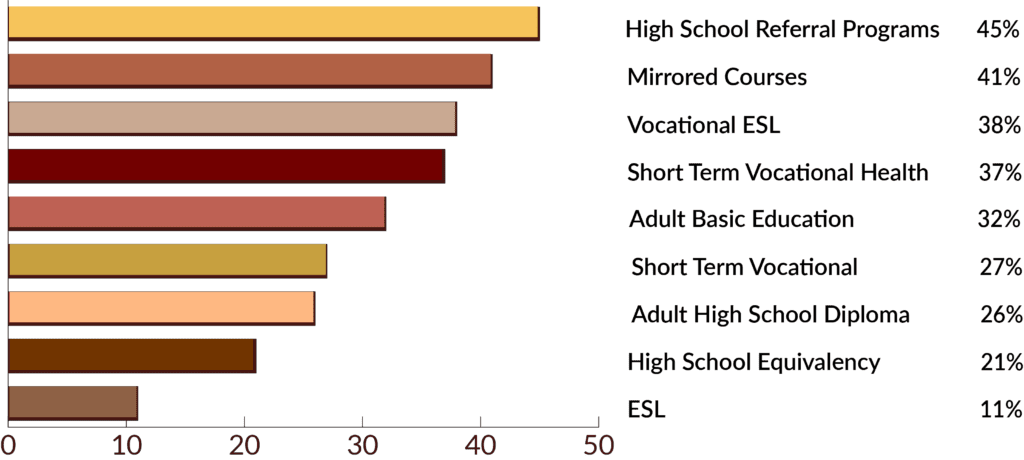The Beginning
Mt. SAC’s noncredit offerings have recently gone through a major expansion. As the credit arm of the college was embarking on guided pathways planning and implementation, the noncredit programs were well-positioned to enter those conversations because they had been working to build student-centered pathways to careers and credit programs with components of guided pathways like embedded support, career connections, and transitions support. As college faculty and staff became more aware of the need and benefits of clear pathways for students, credit faculty became more open to collaborating with and learning about ways noncredit classes can be used to support students without asking them to enroll in more credit-bearing classes. AB 705 legislation also presented an opening for noncredit faculty to offer English, math, and ESL support courses contextualized to specific pathways, which provide students with just-in-time support. Mt. SAC now has one of the largest noncredit programs in the state, largely due to their agility and creativity in identifying where students would benefit from a noncredit course or pathway, and collaborating with other faculty to develop curriculum that works to improve success.
Program Components
Mt. SAC’s noncredit programs support students in noncredit certificate attainment, job readiness, credit degrees and certificates.
Credit for noncredit coursework
Every vocational ESL pathway is connected to a credit program. Students who complete the noncredit pathway and are interested in continuing into the credit program are able to earn credit for the work they have already completed through articulation agreements with local high school classes.
Noncredit students interested in credit classes can join the credit classes as a noncredit student in a mirrored course. This is made possible through an agreement with the credit faculty to designate spots in the class for noncredit students. The noncredit students can earn college credit for the class through credit-by-exam or articulation agreements if they choose to enter a credit degree or certificate program. Many students who take a credit class as a noncredit student decide to continue in credit classes to earn degrees and certificates.
Support for students on certificate, degree, and transfer pathways
Transfer-level English and math support: the Academic Interventions for Math and English (AIME) program contacts students who drop out of transfer-level English or math. It provides a noncredit support class that starts later than the regular semester term, allowing students to enter at any time during the term, and is offered in intersession for students who failed or dropped out of transferlevel English or math.
Contextualized support: noncredit support classes, which are taught by noncredit and credit faculty, were developed after faculty identified a skill or concept that students struggle with in their classes and programs. For example, nursing faculty identified that students taking pharmacology struggled with the math required to calculate dosages, which was preventing them from moving forward in the program. A noncredit healthcare math course was developed to teach the math skills needed to prepare students for the dosages class. By taking this noncredit math class in the summer or intersession, students are prepared to enter the class. In another example, biology faculty recognized that students were struggling to read the textbook. The faculty piloted a noncredit class contextualized to biology that started in week 2 of the semester and ran for four weeks; it supported students in decoding the textbook and working through the lab assignments. The faculty are reviewing how the pilot worked and considering next steps.
Career training and transition support
Many students enroll in Mt. SAC’s noncredit programs to build job readiness or prepare for a specific field of work. Mt. SAC offers flexibility in the pathways for students looking to transition to work or college:
- General workplace computer skills and applications such as accounting software, Microsoft Office Suite, workplace communication, and resume writing prepare students to enter the workplace
- Noncredit distance education, short-term courses, and module-based learning leads to immediate employment or college transition, particularly for underserved populations facing multiple barriers to enrollment.
- Mirrored courses offer noncredit students the opportunity to take credit courses as a noncredit student. If students decide to move into the credit program, they are able to transition by way of articulation agreements or credit-by-exam.
- Noncredit courses are free, lower risk opportunities to try out a field or discipline. Students earn either the noncredit or credit certificate by taking mirrored courses.
- Short-term vocational certificates are connected to pathways in high-wage, high-growth fields in the region such as Contact Tracing, EMT, Nursing, Payroll and Accounting, and more.
Program Outcomes
Noncredit to credit transitions
The chart below show the percentage of students enrolled in noncredit programs in the 2018-2019 and 2019-2020 cohorts who transitioned to credit degree and certificate programs

Further Development
In part, Mt. SAC’s noncredit programs grew due to the partnerships between credit and noncredit faculty, their creativity in recognizing opportunities to support students in college and career, and their agility in taking action. The recently developed contact tracer certificate program, which Mt. SAC developed during the COVID-19 pandemic, filled a training need in the community quickly and during a time of high unemployment. Noncredit has used a similar approach to building bridges or supports for credit students by working closely with credit faculty to identify student support needs and develop noncredit curriculum to fill the gap.